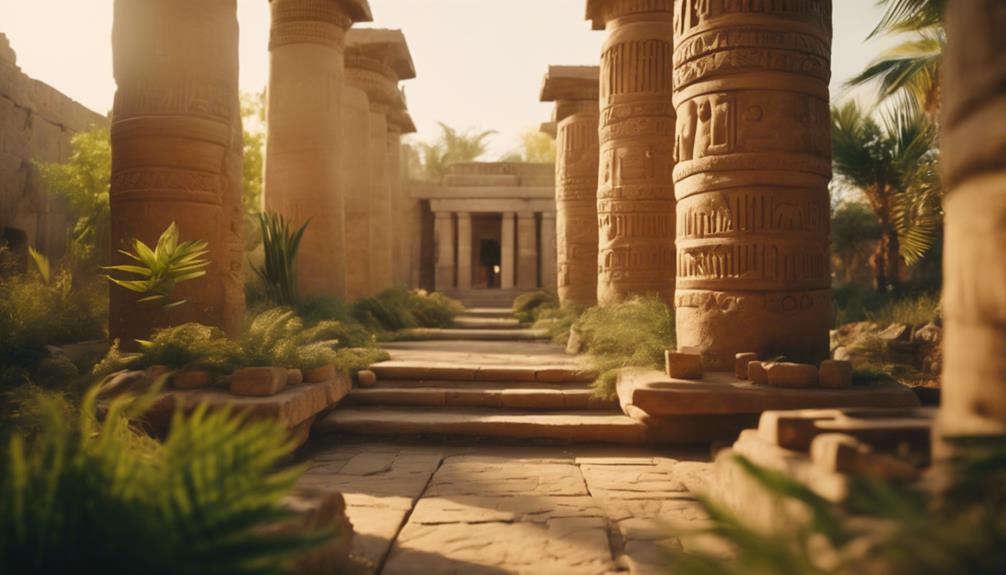As we explore the origins of herbalism, we find that it spans an astonishing 60,000 years, dating back to our Neanderthal ancestors who used medicinal plants. Ancient civilizations like Egypt, Mesopotamia, China, and India developed unique herbal practices. In Greece and Rome, physicians like Hippocrates and Dioscorides used herbal remedies. Apothecaries played a crucial role in preserving and disseminating herbal knowledge, while botanical gardens facilitated the discovery of new medicinal plants. From indigenous cultures to Western herbalism, the evolution of herbalism is a rich and complex tapestry. And as we continue to uncover the threads of this narrative, we'll discover even more about the fascinating history of herbalism.
Key Takeaways
• Herbalism has a 60,000-year history, with ancient civilizations like Neanderthals, Egyptians, Greeks, and Chinese using medicinal plants.
• Ancient Mesopotamia, Egypt, and Greece developed sophisticated herbal medicine systems, with written records of herbal remedies and practices.
• Traditional Chinese Herbalism emerged over 5,000 years ago, emphasizing Yin and Yang, Qi, and Five Elements theory, with over 11,000 plant species used medicinally.
• Ayurvedic Herbal Medicine originated in ancient India around 3300 BCE, integrating herbs with diet and lifestyle changes, with over 2,000 herbs described in Charaka Samhita.
• Apothecaries, herbalists, and physicians like Hippocrates, Dioscorides, and Galen practiced herbalism, bridging traditional knowledge with scientific exploration and pharmacology advancements.
Ancient Roots of Herbalism
Looking back in time, we find that the history of herbalism stretches back an astonishing 60,000 years, with evidence of medicinal plant use dating back to our ancient ancestors. The roots of herbalism are indeed ancient, and it's fascinating to explore how our earliest human relatives utilized plants for medicinal purposes.
Take the Neanderthals, for instance, who used plants like willow, St. John's wort, and yarrow to treat ailments. Fast-forward to ancient Egypt, where the Ebers Papyrus, circa 1500 BCE, contains over 700 medicinal formulas using herbs. In ancient Greece, the renowned physician Hippocrates incorporated herbal remedies, including willow bark, into his medical practice.
Meanwhile, traditional healing systems like Traditional Chinese Medicine have been utilizing herbal treatments for thousands of years. It's clear that herbalism has a rich, ancient history that spans cultures and continents.
As we explore further into the history of herbalism, it's remarkable to see how our ancestors' understanding of medicinal plant use has shaped the practice into what it is today.
Mesopotamia's Herbal Legacy

As we explore the rich herbal legacy of Mesopotamia, we find that this ancient civilization, often referred to as the cradle of civilization, had a profound understanding of medicinal plants dating back to 2700 BCE.
Mesopotamia's herbal heritage is a testament to their advanced knowledge of medicinal plants, with over 250 plants utilized for various ailments and health treatments. We discover that their herbal knowledge was meticulously documented on clay tablets, including the famous Assyrian herbal text known as the 'Diagnostic Handbook.'
This ancient text provides valuable insights into Mesopotamian herbal medicine, which was often practiced alongside magical and religious rituals. The Mesopotamian healers, known as asipu and asu, would use plants like licorice, myrtle, and saffron for medicinal purposes, showcasing their sophisticated understanding of herbal medicine.
As we delve further into Mesopotamia's herbal heritage, we appreciate the significant contributions this ancient civilization made to the development of herbalism.
Egyptian Herbal Healing

We shift our focus to ancient Egypt, where a rich tradition of herbal healing emerged over 5,000 years ago. Leaving behind a treasure trove of medicinal knowledge in the revered Ebers Papyrus. This ancient medical text contains over 700 plant-based remedies for various ailments and diseases, showcasing the Egyptians' extensive understanding of medicinal plant formulas.
They utilized herbs like aloe vera, garlic, and coriander for medicinal purposes and healing practices, which played a significant role in their culture and religious rituals. The Egyptians believed in the healing powers of plants, intertwining herbal medicine with their spiritual beliefs.
Their herbal healing traditions had a profound impact on the development of herbal medicine in other ancient civilizations like Greece and Rome. The Ebers Papyrus remains a valuable resource, offering insights into the Egyptians' sophisticated understanding of herbal healing.
As we explore the history of herbalism, it's clear that the Egyptians made substantial contributions to the field, paving the way for future generations to build upon their knowledge.
Traditional Chinese Herbalism

Over 5,000 years ago, Traditional Chinese Herbalism emerged as an essential component of Traditional Chinese Medicine, focusing on the strategic use of herbs to restore balance and harmony within the body.
We've been fascinated by the ancient roots of Chinese herbal medicine, which is based on texts like the Shennong Ben Cao Jing. This medicinal approach categorizes herbs by taste, temperature, and therapeutic actions, allowing practitioners to create effective herbal remedies.
Here are some key aspects of Traditional Chinese Herbalism:
- Plant diversity: Chinese herbalists utilize over 11,000 plant species and 1,500 animal species for medicinal purposes.
- Holistic approach: The practice emphasizes the concept of Yin and Yang, Qi (vital energy), and the Five Elements theory to diagnose and treat health conditions.
- Influence on global healthcare: Chinese Herbalism has influenced healthcare practices worldwide and remains a popular form of traditional medicine.
- Formulations: Herbal remedies are formulated into teas, powders, and pills to promote healing and wellness.
Ayurvedic Herbal Medicine

As we explore the rich history of herbalism, we now turn our attention to Ayurvedic herbal medicine, which has its roots in ancient India.
We'll examine how this holistic approach to health emphasizes the balance of mind, body, and spirit through natural remedies and lifestyle practices.
Roots in Ancient India
In ancient India, around 3300 BCE, Ayurvedic herbal medicine originated, laying the foundation for a holistic approach to health that would flourish for centuries to come. We find ourselves drawn to the rich heritage of this traditional system, which emphasizes the use of herbs and plants to promote overall well-being.
Here are a few key aspects of Ayurvedic herbal medicine:
- The Charaka Samhita, an ancient text, details herbal remedies and principles, outlining treatment strategies based on individual constitutions.
- Ayurvedic practitioners, known as Vaidyas, integrate herbal remedies with diet, lifestyle changes, and spiritual practices to prevent illness.
- Over 2000 herbs and their medicinal properties are described in the Charaka Samhita, showcasing the depth of Ayurvedic herbal medicine.
- This holistic approach to health focuses on balancing the body's energies (doshas) using herbs like turmeric, holy basil, and ashwagandha.
As we delve into the roots of Ayurvedic herbal medicine, we can appreciate the significance of this ancient tradition in shaping the course of medical history.
Holistic Healing Methods
We'll explore the principles and practices that define Ayurvedic herbal medicine's holistic approach to healing, where the whole person – body, mind, and spirit – is treated, not just symptoms.
This ancient Indian system of herbal medicine, dating back to around 3300 BCE, emphasizes preventive care and lifestyle practices to maintain health and harmony within the body.
Ayurveda utilizes over 300 herbs, including Turmeric and Holy Basil, to address various health issues and promote overall well-being. Practitioners of Ayurveda consider each person's unique constitution, or dosha, to tailor herbal treatments and dietary recommendations for optimal health.
By categorizing herbs based on their taste, potency, and post-digestive effect, Ayurvedic practitioners can customize treatments for individual constitutions. Through this holistic healing approach, Ayurvedic herbal medicine aims to restore balance and promote overall wellness.
Natural Remedies Used
We turn to the diverse array of natural remedies used in Ayurvedic herbal medicine, which leverages over 300 herbs to address various health issues and promote overall well-being. This traditional healing system has been practiced for centuries, and its herbal remedies have been passed down through generations.
Here are some key aspects of Ayurvedic herbal medicine:
- Classification of Herbs: Herbs are categorized based on their taste and effects on the body, which helps practitioners create personalized herbal preparations.
- Medicinal Properties: Herbs like Turmeric, Holy Basil, Ashwagandha, and Triphala are renowned for their medicinal properties, making them staples in Ayurvedic herbal medicine.
- Balancing the Doshas: Ayurvedic herbal remedies aim to balance the three doshas (Vata, Pitta, Kapha) to maintain health and prevent disease.
- Ancient Texts: Ayurvedic texts like Charaka Samhita and Sushruta Samhita provide detailed information on herbal formulations and their therapeutic uses.
Greek and Roman Herbalism

As we explore Greek and Roman Herbalism, we're going to examine how these ancient civilizations intertwined mythology and botany, as well as how they developed remedies that still influence modern herbal medicine.
We'll look at how Greek gods were associated with specific herbs and how the Romans built upon Greek knowledge to create their own unique herbal remedies.
Greek Gods and Herbs
In ancient Greek mythology, gods like Apollo, Asclepius, and Artemis were revered for their associations with healing and herbalism, setting the stage for a rich tradition of botanical medicine. These gods embodied the connection between nature and healing, inspiring a deep understanding of the medicinal properties of plants.
Here are some key highlights of Greek herbalism:
- Asclepius, the god of medicine, was often depicted with a staff entwined with a snake, symbolizing healing and medicine.
- Hippocrates, the Father of Medicine, integrated herbal remedies into his medical practice, solidifying the importance of botanicals in healthcare.
- Dioscorides' De Materia Medica detailed over 600 medicinal plants, showcasing the extensive knowledge of Greek herbalism.
- Greek physicians like Hippocrates and Dioscorides laid the groundwork for a thorough understanding of herbal medicine, influencing future generations of healers.
The intersection of Greek mythology and herbalism paved the way for a rich tradition of botanical medicine, where the gods inspired a deeper understanding of nature's healing properties.
Roman Herbal Remedies
We shift from Greek herbalism to Roman herbal remedies, which drew heavily from Greek herbalism, with Dioscorides' seminal work, De Materia Medica, serving as a foundational text that influenced Roman physicians like Galen and Pliny the Elder.
Roman herbal remedies were deeply rooted in Greek practices, and we can see this in the works of these prominent physicians. Galen, for instance, incorporated herbal remedies into his medical practices, using plants like aloe, chamomile, and lavender to treat various ailments. The Roman military also utilized herbal medicines to treat wounds, fevers, and digestive issues.
Roman herbalism played an essential role in the development of Western herbal medicine practices, and its influence can still be seen today. We find that Roman herbal remedies not only borrowed from Greek practices but also contributed significantly to the evolution of herbal medicine.
Medieval Herbal Practices

During the Middle Ages, the works of Greek physician Dioscorides had a significant impact on the development of herbal practices in Europe. We can see how his ideas influenced the way herbalism evolved in Europe during this period.
Here are some key aspects of medieval herbal practices:
- Preservation of knowledge: Benedictine monasteries played an important role in preserving and disseminating herbal knowledge during the medieval period.
- Women's role: Herbal medicine was mainly practiced by women in Germanic tribes, passing down knowledge through generations.
- Translation and integration: The Middle Ages saw the translation of important herbal texts and the incorporation of herbalism into medical care.
- Influence from the East: Herbal knowledge in the medieval era was sourced primarily from the Middle East and Asia, shaping the development of herbal practices in Europe.
In this medieval landscape, we see the threads of Dioscorides' work woven into the fabric of European herbalism. His texts, preserved and translated by monks and scholars, influenced the way people approached herbal medicine.
As we explore further into the history of herbalism, we begin to appreciate the intricate tapestry of influences that have shaped this ancient practice.
Early Modern Herbal Renaissance

As we explore the Early Modern Herbal Renaissance, we find ourselves in the midst of a vibrant era that saw a resurgence of interest in herbalism. This period, marked by the European Herbal Revival, brought about significant changes, including the emergence of apothecaries as key players in the field and the establishment of botanical gardens that would shape the course of herbal medicine.
As we examine these developments, we'll uncover the complexities of this pivotal moment in the history of herbalism.
European Herbal Revival
In the early modern era, herbalism experienced a remarkable resurgence in Europe, sparking a renewed interest in the therapeutic potential of plants. This European Herbal Revival, also known as the Early Modern Herbal Renaissance, was characterized by a surge in herbal publications and a renewed focus on traditional herbal practices.
Here are some key highlights of this period:
- English herbals like John Gerard's 'Herball' and Nicholas Culpeper's 'Complete Herbal' became popular sources of herbal knowledge.
- The European Herbal Renaissance incorporated American plants into traditional European herbal practices.
- The 16th century marked the peak of herbal publications in Europe, contributing to the growth of herbal knowledge.
- Benedictine monasteries played a significant role in preserving and disseminating herbal knowledge during the European Herbal Revival.
During this time, herbalism became more widespread and accessible, thanks to the efforts of herbalists, physicians, and monks who contributed to the preservation and dissemination of herbal knowledge. The European Herbal Revival paved the way for the development of modern herbalism, solidifying its place in the history of herbalism.
Apothecaries' New Role
We find apothecaries emerging as pivotal figures in the early modern herbal renaissance, specializing in preparing and dispensing herbal remedies that would transform the face of traditional medicine. As we explore this period, we see apothecaries playing an essential role in bridging the gap between traditional herbal practices and the scientific exploration of herbal medicine.
Their knowledge of herbal remedies expanded greatly with the development of new botanical discoveries and advancements in pharmacology. During this time, apothecaries gained recognition for their expertise in compounding and prescribing herbal medicines, integrating traditional herbal knowledge with emerging scientific principles. This integration laid the foundation for modern pharmacy and herbal medicine practices.
As a result, apothecaries became vital figures in the early modern herbal renaissance, driving the shift towards a more scientific approach to herbalism. By combining traditional knowledge with new discoveries, apothecaries paved the way for a more thorough understanding of herbal remedies and their applications in modern medicine.
Botanical Gardens Rise
During the Early Modern Herbal Renaissance, botanical gardens sprouted up across Europe, providing essential spaces where herbalists, botanists, and apothecaries could cultivate, study, and exchange knowledge about medicinal plants.
As we explore this pivotal period in herbalism, we find that botanical gardens played an important role in the development of herbal medicine.
Here are some key aspects of botanical gardens during this time:
- Classification and preservation: Botanical gardens facilitated the classification, preservation, and propagation of medicinal plants, allowing for a deeper understanding of their properties and uses.
- Botanical exploration: These gardens enabled herbalists and botanists to conduct research, identify new plant species, and document herbal properties.
- Herbal knowledge exchange: Botanical gardens provided a platform for the exchange of herbal knowledge among experts, fostering collaboration and advancing the field of herbalism.
- Propagation and cultivation: By cultivating medicinal plants, botanical gardens enabled the large-scale production of herbal remedies, making them more accessible to the public.
The rise of botanical gardens during the Early Modern Herbal Renaissance significantly contributed to the expansion and systematic study of herbal medicine practices, paving the way for future advancements in the field.
Herbalism in Indigenous Cultures

As we explore the world of herbalism, it's striking to discover the profound impact indigenous cultures have had on the development of traditional healing practices. For centuries, indigenous cultures worldwide have practiced herbalism, relying on traditional knowledge and plant remedies for healing.
In North America, Native American tribes like the Cherokee and Navajo have a rich history of herbal medicine, using plants like echinacea, sage, and black cohosh.
Similarly, in Australia, Aboriginal healers use bush plants like eucalyptus, tea tree, and kangaroo apple for medicinal purposes.
In Africa, traditional healers, like South Africa's sangomas, utilize indigenous plants such as aloe, rooibos, and devil's claw for healing rituals.
Indigenous herbalism emphasizes a deep connection to nature, spiritual beliefs, and the interplay between plants and human health. By understanding and respecting these traditional practices, we can gain a deeper appreciation for the roots of herbalism and its continued relevance today.
Evolution of Western Herbalism

From ancient civilizations like Egypt, Greece, and Rome, where herbal knowledge was meticulously documented and passed down through texts and oral traditions, Western herbalism has evolved over the centuries. We've seen a rich history unfold, with significant contributions from various cultures.
Here are some key milestones in the evolution of Western herbalism:
- Monastic communities: In the Middle Ages, monastic communities played a crucial role in preserving and disseminating herbal knowledge, contributing to the growth of herbal practices.
- Herbal publications: The early modern era saw a surge in herbal publications, including influential English herbals, and the incorporation of American plants into herbal medicine.
- Notable figures: John Gerard and Nicholas Culpeper published influential English herbals, further advancing the practice of Western herbalism.
- Shift to chemical drugs: The 17th and 18th centuries marked a shift towards chemical drugs and away from plant-based therapies, impacting the trajectory of herbal medicine in Western societies.
Throughout this journey, we've seen the use of plants and herbs mentioned in various herbal traditions, with a focus on the use of herbal ingredients in herbal products.
The evolution of Western herbalism is a testimony to the enduring power of herbalism in modern society.
Frequently Asked Questions
Where Did Herbalism Originate?
We're often curious about the roots of herbalism, and the answer takes us back in time.
Herbalism originated in ancient civilizations, specifically in Egypt, Mesopotamia, India, China, Greece, and Rome.
The use of plants as medicines predates written records, with archaeological evidence dating back an astonishing 60,000 years.
It's fascinating to think that our ancestors relied on herbal remedies long before modern medicine existed.
Who Practices Herbalism?
We find that herbalism is practiced by a diverse range of experts, including herbalists, naturopathic physicians, chiropractors, medical doctors, and practitioners of Traditional Chinese Medicine.
These professionals undergo specialized training, combining conventional medical science with herbal medicine expertise.
Organizations like the American Herbalists Guild and the American Association of Naturopathic Physicians can help us locate qualified herbalists for guidance and treatment.
Who Is the Father of Herbalism?
We identify Theophrastus, a Greek philosopher and student of Aristotle, as the 'Father of Botany' and a pioneer in herbalism. His groundbreaking work, 'Enquiry into Plants,' detailed over 500 plants and their medicinal uses, laying the foundation for future herbalists and botanists.
Theophrastus' contributions greatly influenced herbal knowledge in ancient Greece and Rome, shaping our understanding of plants' properties and medicinal benefits.
Who Is the Mother of Herbalism?
As we explore the world of herbalism, we find ourselves asking, who's the mother of herbalism? Like a beacon of wisdom, Hildegard von Bingen shines bright, earning her the title.
This 12th-century German Benedictine abbess and herbalist penned 'Physica,' an all-encompassing text on natural healing and plant medicine. Her holistic approach, integrating spiritual and medicinal aspects, greatly influenced the development of herbalism in the Middle Ages, and her legacy continues to inspire modern practitioners.
Conclusion
As we conclude our journey through the origins of herbalism, some might argue that herbalism is outdated, replaced by modern medicine. However, we've seen how herbalism has evolved alongside human civilization, adapting to new discoveries while preserving ancient wisdom.
By embracing this rich heritage, we can integrate the best of both worlds, harnessing the power of nature to inform modern healthcare.










